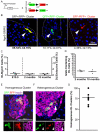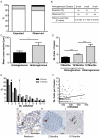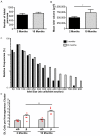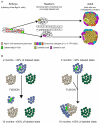Pancreatic neurogenin 3-expressing cells are unipotent islet precursors
- PMID: 19793886
- PMCID: PMC2761107
- DOI: 10.1242/dev.039214
Pancreatic neurogenin 3-expressing cells are unipotent islet precursors
Abstract
Pancreatic islet endocrine cells arise during development from precursors expressing neurogenin 3 (Ngn3). As a population, Ngn3(+) cells produce all islet cell types, but the potential of individual Ngn3(+) cells, an issue central to organogenesis in general and to in vitro differentiation towards cell-based therapies, has not been addressed. We performed in vivo clonal analyses in mice to study the proliferation and differentiation of very large numbers of single Ngn3(+) cells using MADM, a genetic system in which a Cre-dependent chromosomal translocation labels, at extremely low mosaic efficiency, a small number of Ngn3(+) cells. We scored large numbers of progeny arising from single Ngn3(+) cells. In newborns, labeled islets frequently contained just a single tagged endocrine cell, indicating for the first time that each Ngn3(+) cell is the precursor of a single endocrine cell. In adults, small clusters of two to three Ngn3(+) progeny were detected, but all expressed the same hormone, indicating a low rate of replication from birth to adult stages. We propose a model whereby Ngn3(+) cells are monotypic (i.e. unipotent) precursors, and use this paradigm to refocus ideas on how cell number and type must be regulated in building complete islets of Langerhans.
Figures





References
-
- Bonal, C. and Herrera, P. L. (2008). Genes controlling pancreas ontogeny. Int. J. Dev. Biol. 52, 823-835. - PubMed
-
- Bonal, C., Thorel, F., Ait-Lounis, A., Reith, W., Trumpp, A. and Herrera, P. L. (2009). Pancreatic inactivation of c-Myc decreases acinar mass and transdifferentiates acinar cells into adipocytes in mice. Gastroenterology 136, 309-319. - PubMed
-
- D'Amour, K. A., Bang, A. G., Eliazer, S., Kelly, O. G., Agulnick, A. D., Smart, N. G., Moorman, M. A., Kroon, E., Carpenter, M. K. and Baetge, E. E. (2006). Production of pancreatic hormone-expressing endocrine cells from human embryonic stem cells. Nat. Biotechnol. 24, 1392-1401. - PubMed
-
- Delacour, A., Nepote, V., Trumpp, A. and Herrera, P. L. (2004). Nestin expression in pancreatic exocrine cell lineages. Mech. Dev. 121, 3-14. - PubMed
Publication types
MeSH terms
Substances
LinkOut - more resources
Full Text Sources
Other Literature Sources
Molecular Biology Databases
Research Materials

